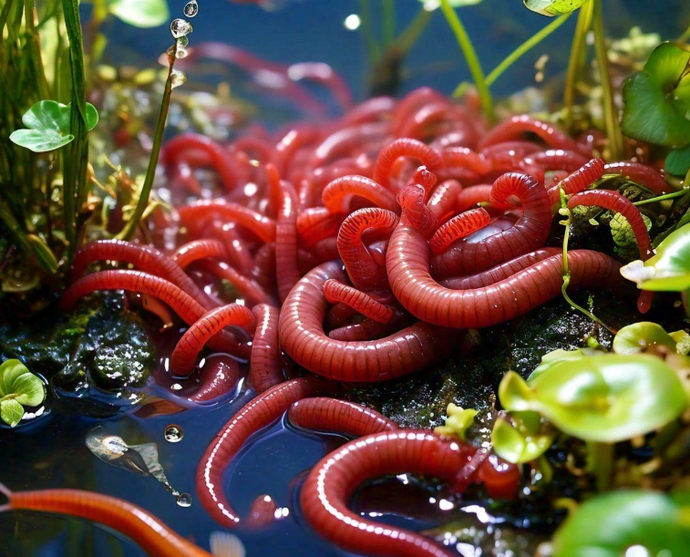Red wigglers: Learn their benefits
Using Red Wigglers for Effective Organic Waste Disposal
Using red wigglers for organic waste disposal provides a compelling strategy to handling food scraps while advertising environmental sustainability. These worms not just improve waste decomposition however also generate valuable worm spreadings, which can considerably boost soil wellness. Their capability to refine large volumes of natural material with marginal effort placements them as an available remedy for homes and areas alike. Recognizing the nuances of setting up an effective worm container and maintaining an ideal environment is critical for maximizing their benefits. The following action in this process may shock you.
Advantages of Making Use Of Red Wigglers
One of the most compelling advantages of using red wigglers for organic waste disposal is their amazing effectiveness in composting. These worms, scientifically referred to as Eisenia fetida, are particularly adapted for damaging down organic products, allowing them to process waste as much as twice their body weight each day. This quick decomposition not only speeds up the composting procedure however likewise creates nutrient-rich worm spreadings that dramatically boost dirt high quality.
Furthermore, red wigglers add to a reduction in landfill waste. By diverting natural products from garbage dumps, they assist reduce methane discharges-- a potent greenhouse gas. This ecological advantage is critical in the battle versus climate change.
Moreover, red wigglers are low-maintenance and can grow in numerous atmospheres, making them easily accessible for both beginner and experienced composters. Their capacity to duplicate swiftly guarantees a stable populace, assisting in continuous waste processing.
Establishing Up Your Worm Bin
Creating a reliable worm bin is essential for making the most of the advantages of composting with red wigglers. The primary step is picking a suitable container. A container made from plastic or wood, with an ability of 10 to 20 gallons, is optimal. Ensure the container has sufficient water drainage holes to prevent excess wetness, as red wigglers thrive in a moist but not soaked environment.
(eisenia fetida worms for sale)Next, prepare the bedding product, which acts as the worms' habitat and food resource. Shredded paper, cardboard, and coconut coir are superb alternatives. Purpose for a bed linens deepness of about 4 to 6 inches. The bin should be positioned in a dark, temperature-controlled location, preferably between 55 ° F and 77 ° F, to preserve worm activity.
As soon as the bin is set up, present the red wigglers, enabling them to acclimate to their brand-new environment. A properly maintained bin will certainly not only sustain the health of the worms however also assist in efficient decay of natural waste.
(red wiggler fishing worms)
What to Feed Red Wigglers
An understanding of the proper diet plan for red wigglers is important for maintaining a healthy and balanced worm populace and enhancing composting effectiveness. These items not only give essential nutrients yet additionally contribute to the moisture equilibrium within the worm container.
It is important to avoid particular foods that can hurt the worm population. Red wigglers should not be fed meat, milk products, oily foods, or refined products, as these can attract parasites and produce unpleasant smells. red wigglers. Furthermore, citrus fruits and spicy foods need to be lessened, as their acidity can be detrimental to worms
To promote optimal digestion, food should be sliced right into smaller sized items, helping with quicker failure and consumption. Introducing food in small amounts is additionally crucial; overfeeding can result in anaerobic problems and attract undesirable pests. Keeping track of the worm bin for food usage prices will help make certain red wiggler fishing worms that red wigglers are getting an ample diet plan while keeping an effective composting setting. Proper feeding techniques are important for cultivating a flourishing environment within the worm bin.
Keeping Your Worm Environment
A well-kept worm habitat is vital for the health and wellness and efficiency of red wigglers. To make sure ideal conditions, it is important to keep an eye on temperature level, wetness, and aeration within the worm bin (red wigglers).
Moisture levels need to be maintained regular; the bed linen must be moist however not soggy. A good guideline is to maintain moisture at approximately 70% to 80%. If the bed linens comes to be as well wet, it can lead to anaerobic problems that are unsafe to the worms. Including dry carbon-rich materials, such as shredded paper or cardboard, can aid take in excess wetness.

Making Use Of Worm Spreadings in Horticulture
Rich in nutrients and beneficial bacteria, worm castings offer as a phenomenal organic fertilizer for gardening. Produced through the gastrointestinal processes of red wigglers, these castings consist of a variety of crucial nutrients, consisting of nitrogen, phosphorus, and potassium, which advertise durable plant development. Unlike artificial plant foods, worm spreadings use a slow-release system, making sure that nutrients are readily available to plants over an extensive duration, consequently minimizing the danger of nutrient leaching and dirt exhaustion.
In addition to nutrient web content, worm castings enhance dirt structure and aeration, boosting wetness retention and drainage. The microbial life existing in worm castings aids to reduce pathogens and advertises a healthy dirt environment, additional profiting plant health and wellness. When incorporated right into the soil or made use of as a top clothing, worm castings can dramatically increase seed germination prices, root growth, and general plant vitality.
For optimal outcomes, gardeners need to use worm spreadings at a price of 1-2 inches per square foot, mixing them right into the soil or including them right into potting mixes. In general, using worm spreadings is an environmentally friendly method to improving soil fertility and making certain thriving yard atmospheres.
Conclusion
